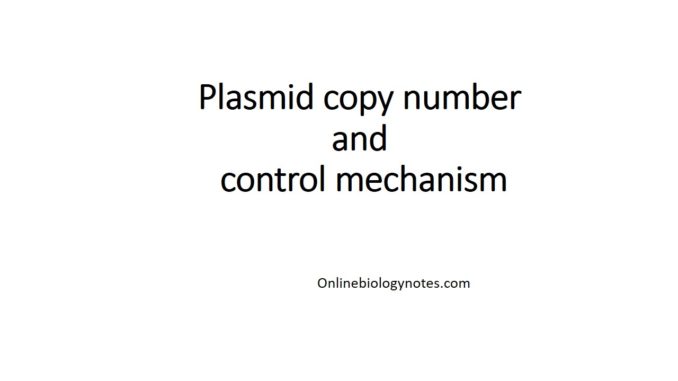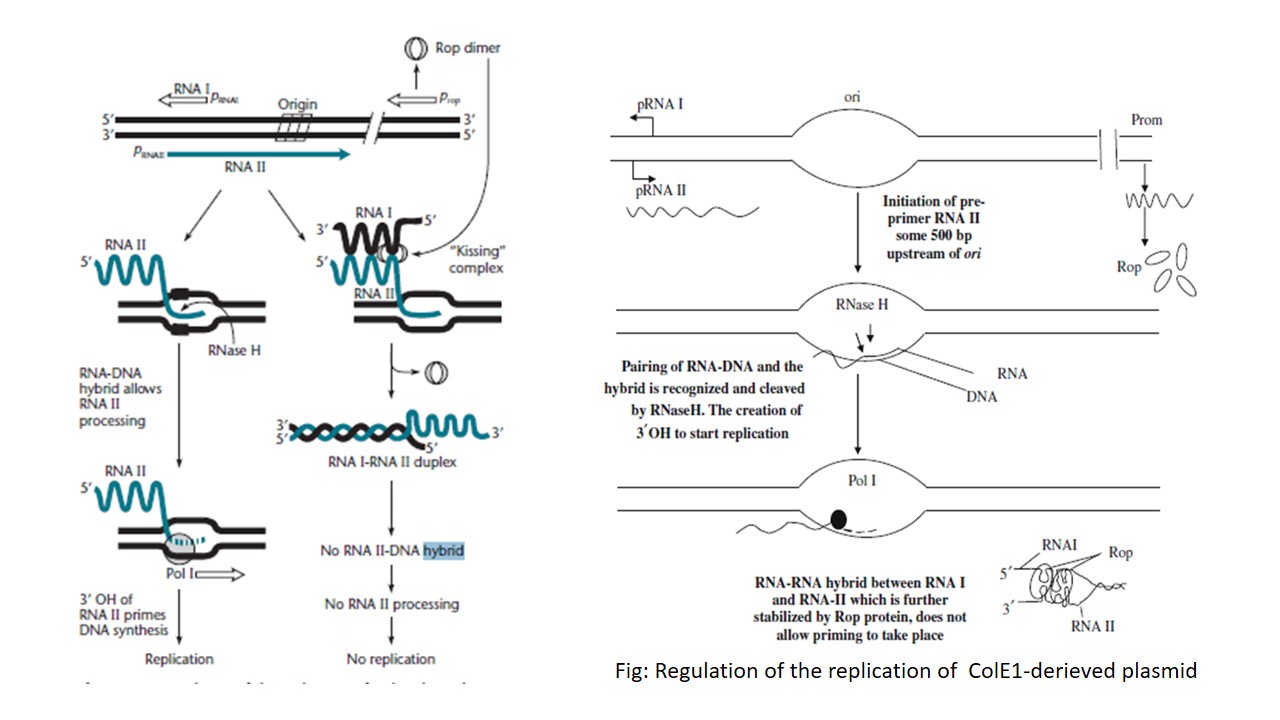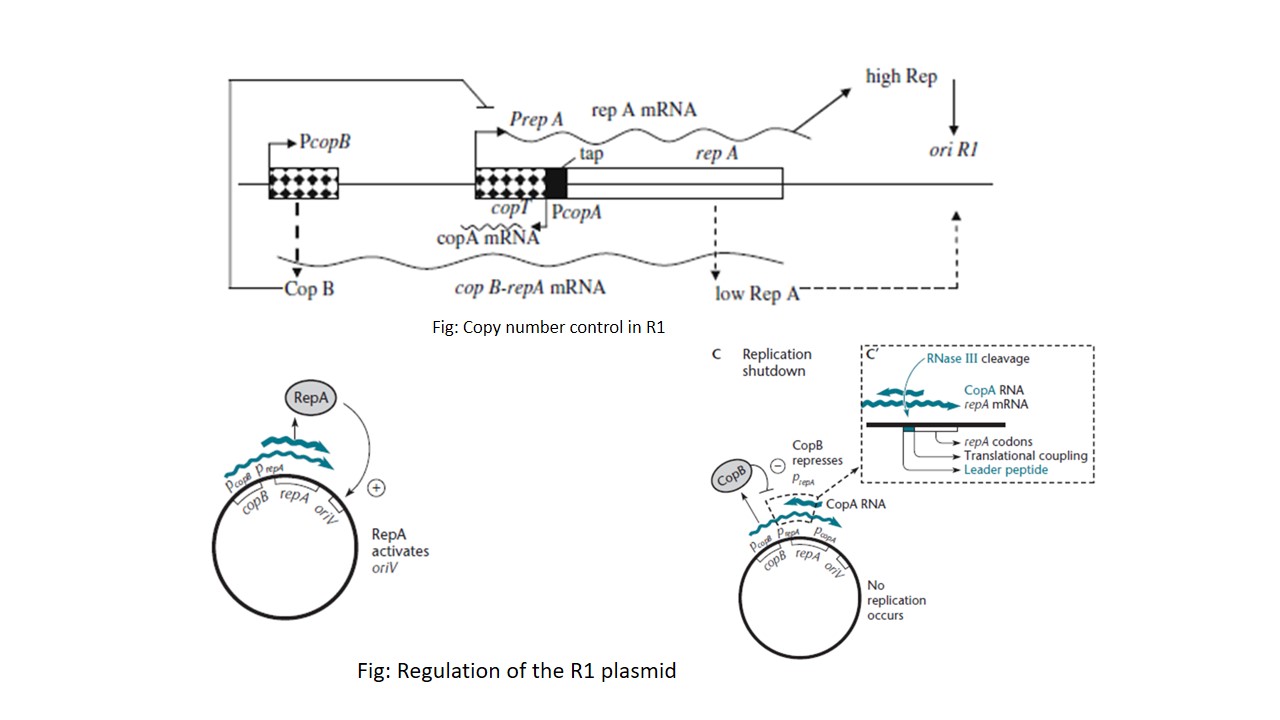
Plasmid copy number:
- The copy number plasmid means the number of plasmids that are normally present in a single bacterial cell.
- The size and copy number of a plasmid is important.
- Cloning is concerned with it.
- Plasmid size that less than 10 kb is desirable for a cloning vector.
- Some plasmids, especially the larger ones, are stringent.
- Larger plasmids and have a low copy number which might be just one or two per cell.
- Others are called relaxed plasmids which are present in multiple copies of 50 or more per cell.
- Large quantities of the recombinant DNA molecule can be obtained when multiple copies of the cloning vector are present in the cell.
- Naturally occurring plasmids are usually stably maintained in their bacterial hosts.
- This stability often must be accomplished despite a very low number of plasmid copies per cell.
Plasmid replication and control:
- Many plasmids are replicated as double-stranded circular molecules.
- The replication of the double-stranded molecule is the same as that of the chromosome.
- Replication starts from the origin of replication which is known as
- It may be unidirectional ( single directional ) or bidirectional ( both directions).
- When the whole circle is completed, then it segregates.
- However, there are some aspects of replication that differ from that of the chromosome, especially for the multicopy plasmids.
Mechanism of regulation of plasmid copy number
- Regulation of plasmid number is important to control the copy number of the plasmid.
- The mechanisms used by some plasmids to regulate their copy number are :
1) ColE1-derived Plasmids:
- It is the regulation of the processing of primer by complementary RNA
- The mechanism of copy number regulation of the plasmid ColE1 was one of the first to be studied.
- The mechanism of regulation of ColE1-derived plasmids is shown in:
- Replication starts always from the origin of replication (oriV)
- RNA II forms the primer for the plasmid DNA replication.
- At the origin of replication, an RNA-DNA hybrid is formed.
- RNA is RNA II and that DNA is the DNA of plasmid.
- Then RNase cleaves the RNA II.
- RNase H has endonuclease activity which means it can capacity to cleave.
- At the cleaved or cut portion, 3 ʹOH is exposed where the nucleotides will be added by DNA polymerase I.
- Thus the plasmid is replicated.
- But when there is a sufficient number of plasmid its replication needs to be stopped.
- This process is regulated by the RNA I and the Rop protein.
- The Rop protein (sometimes called Rom) helps RNA I to pair with RNA II.
- RNA I is transcribed from the opposite strand to RNA II and is complementary to the first 108 bases of RNA II.
- When there is pairing between RNA I and RNA II, RNAse can not cut the strand.
- When the strand isn’t cleaved further replication is halted.
- Therefore, it inhibits DNA replication.
- The inhibition of replication is almost complete when the concentration of the plasmid reaches about 16 copies per cell which is the copy number of the original ColE1 plasmid.
- Mutations that inactivate Rop cause only a moderate increase in the plasmid copy number.
-

Fig. Regulation of the replication of ColE1-derieved plasmid
- R1 plasmid:
- R1 plasmid is a member of the IncFII family of plasmids.
- Plasmids belonging to the INFII group (R1, R6-5, R100) are self-transmissible, conjugative plasmids found in Enterobacteriaceae.
- R1 plasmid regulates its copy number by regulating the amount of the Rep protein.
- Plasmid requires the Rep protein to initiate the replication.
- It is different from ColE1-derived plasmids which do not require Rep protein. Only the RNA primer was enough for it to start the replication process.
- The Rep protein is required to separate the strands of DNA at the oriV region, often with the help of host proteins, including DnaA.
- Opening the strands is a necessary first step of replication.
- The Rep proteins bind specifically in the DSO of DNA
- By controlling the synthesis of the Rep protein, the plasmid copy number can be controlled.
- The R1 plasmid uses its complementary RNA to inhibit the translation of the mRNA that encodes the Rep protein and inhibits the replication of the plasmid DNA.
- The plasmid-encoded protein RepA is the only plasmid-encoded protein that is required for the initiation of replication.
- Two promoters transcribe the repA gene:
- pcopB
- pCopA
CopB:
- CopB, codes for a protein that represses transcription of the repA gene.
- When the plasmid first enters a bacterial cell, the absence of CopB allows expression of RepA and so there is a burst of replication until the level of CopB builds up to repress this promoter.
- From then on, expression of RepA occurs at a low level from the copB promoter
CopA:
- The second regulatory gene, copA, then regulates the expression of RepA.
- This gene codes for an 80–90-nucleotide untranslated RNA molecule.
- The copA gene is within the region of DNA that is transcribed for the production of RepA but is transcribed in the opposite direction (it is an antisense RNA).
- The copA RNA is therefore complementary to a short region of the repA transcript and will bind to it, interfering with the translation of the RepA protein.
- When the plasmid replicates, the number of copies of the copA gene is doubled and the amount of the copA RNA will therefore increase.
- This causes a marked reduction in further replication initiation, until cell division
-

Copy number control of R1 plasmid
